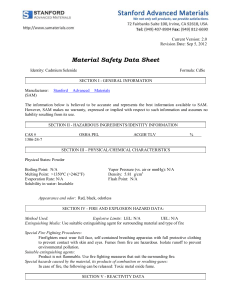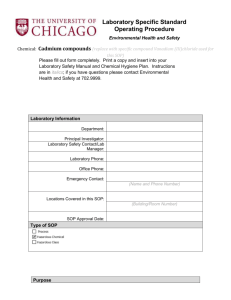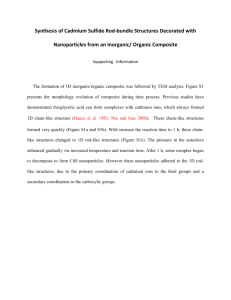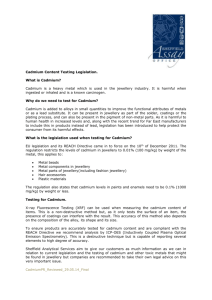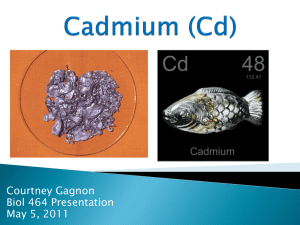UCLA - Environmental Health & Safety
advertisement
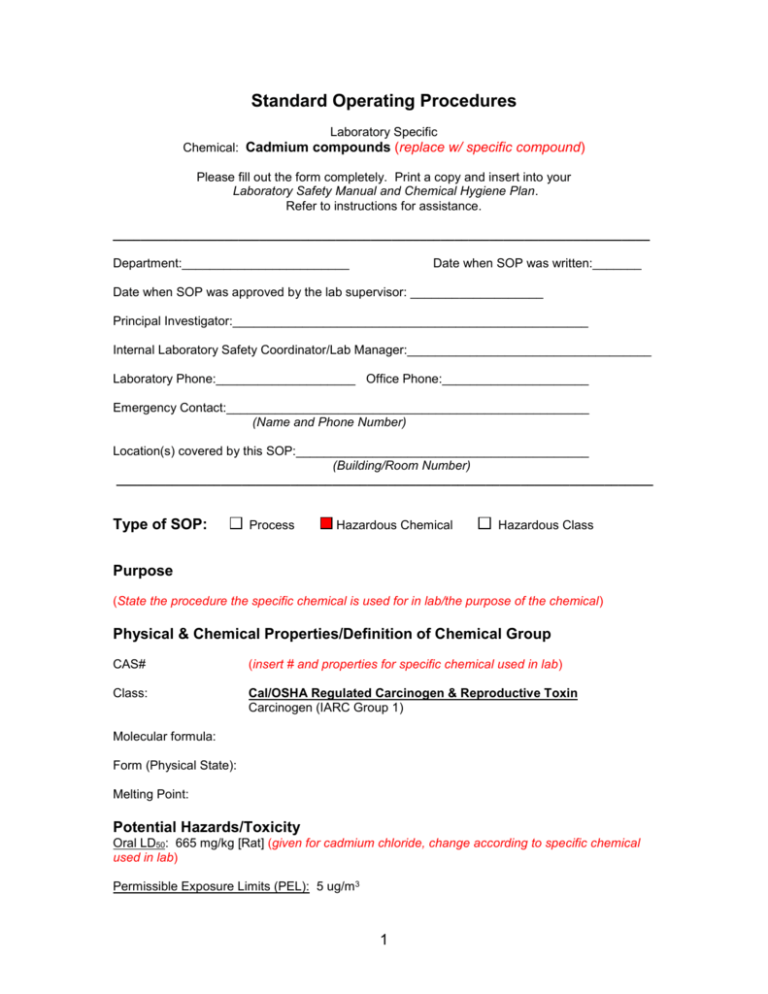
Standard Operating Procedures Laboratory Specific Chemical: Cadmium compounds (replace w/ specific compound) Please fill out the form completely. Print a copy and insert into your Laboratory Safety Manual and Chemical Hygiene Plan. Refer to instructions for assistance. _____________________________________________________________________________ Department:________________________ Date when SOP was written:_______ Date when SOP was approved by the lab supervisor: ___________________ Principal Investigator:___________________________________________________ Internal Laboratory Safety Coordinator/Lab Manager:___________________________________ Laboratory Phone:____________________ Office Phone:_____________________ Emergency Contact:____________________________________________________ (Name and Phone Number) Location(s) covered by this SOP:__________________________________________ (Building/Room Number) _____________________________________________________________________________ Type of SOP: Process Hazardous Chemical Hazardous Class Purpose (State the procedure the specific chemical is used for in lab/the purpose of the chemical) Physical & Chemical Properties/Definition of Chemical Group CAS# (insert # and properties for specific chemical used in lab) Class: Cal/OSHA Regulated Carcinogen & Reproductive Toxin Carcinogen (IARC Group 1) Molecular formula: Form (Physical State): Melting Point: Potential Hazards/Toxicity Oral LD50: 665 mg/kg [Rat] (given for cadmium chloride, change according to specific chemical used in lab) Permissible Exposure Limits (PEL): 5 ug/m3 1 Inhalation: Cadmium absorption is most efficient via respiratory tract. Inhalation of dust may produce irritation, headache, metallic taste and/or cough. Severe exposures may produce shortness of breath, chest pain, and flu-like symptoms with weakness, fever, headache, chills, sweating, nausea and muscular pain. Can cause pulmonary edema, liver and kidney damage and death. Symptoms from inhalation may be delayed for as much as 24 hours. Ingestion: Toxic. Ingested cadmium salts may cause severe and sometimes fatal poisonings. Symptoms can include severe nausea, vomiting, diarrhea, abdominal pains, choking, dizziness, and salivation. Kidney and liver dysfunction may occur. Although as little as 10 - 20 mg of soluble cadmium salts have produced severe toxic symptoms when ingested, death probably requires several hundred mg by oral route. Skin Contact: May cause irritation with redness and pain. Eye Contact: May cause irritation, redness and pain. Chronic Exposure: Chronic exposure to cadmium, even at relatively low concentrations, may result in kidney damage, anemia, pulmonary fibrosis, emphysema, perforation of the nasal septum, loss of smell, male reproductive effects, and an increased risk of cancer of the lung and of the prostate. Decrease in bone density, renal stones, and other evidence of disturbed calcium metabolism may be observed. Aggravation of Pre-existing Conditions: Persons with pre-existing skin disorders, eye problems, blood disorders, prostate problems, or impaired liver, kidney or respiratory function may be more susceptible to the effects of the substance. Personal Protective Equipment (PPE) All persons shall wear personal protective equipment when handling cadmium. This includes wearing a lab coat, nitrile gloves, and closed toe shoes when working with cadmium. Gloves should be changed frequently. Leave lab coats, gloves, and other personal protective equipment in the lab once your work is complete to prevent the spread of this or other chemicals outside of the lab. Engineering Controls All operations involving cadmium should be carried out in a certified chemical fume hood, glovebox, or a ducted Biosafety cabinet to keep airborne level below recommended exposure limits. Chemical fume hoods used as containment areas for particularly hazardous chemicals must have a face velocity of 100 feet/min, averaged over the face of the hood and must be certified annually. Laboratory rooms must be at negative pressure with respect to the corridors and external environment. The laboratory/room door must be kept closed at all times. Vacuum lines are to be protected by HEPA (high efficiency particulate air) filters or higher efficiency scrubbers. First Aid Procedures 2 Inhalation: Remove to fresh air. If not breathing, give artificial respiration. If breathing is difficult, give oxygen. Get medical attention. Ingestion: Induce vomiting immediately as directed by medical personnel. Never give anything by mouth to an unconscious person. Get medical attention immediately. Skin Contact: Immediately flush skin with plenty of water for at least 15 minutes while removing contaminated clothing and shoes. Get medical attention immediately. Wash clothing before reuse. Thoroughly clean shoes before reuse. Contaminated work clothes should be laundered by individuals who have been informed of the hazards of exposure to this substance. Eye Contact: Immediately flush eyes with plenty of water for at least 15 minutes, lifting lower and upper eyelids occasionally. Get medical attention immediately. Special Handling and Storage Requirements An exposure determination for the lab’s use of cadmium must be performed prior to any work. Contact the Industrial Hygiene division of EH&S at (310) 794-5569 to schedule an exposure determination before beginning work with cadmium. All work with cadmium is to be done in the "cadmium" designated area in order to keep contamination to a minimum. (State the location of the designated area including the fume hood where work should be done and the storage location) All chemicals containing cadmium must be secondarily contained with proper signage. Containers of cadmium and designated areas, including storage cabinets, must be labeled with a “CANCER HAZARD” warning. Any persons in this area are required to wear personal protective equipment. Safety shower and eye wash stations should be easily accessible where cadmium is used. All laboratory equipment (such as beakers, pipettes, etc.) used in the "cadmium" designated area are to be labeled as " cadmium contaminated" and are not to be removed from the area without first being decontaminated. Store away from incompatible chemicals including the following: bromine trifluoride, potassium oxidizers, zinc, selenium , tellurium and hydrogen azide. Spill and Accident Procedure Toxic fumes of cadmium may be given off in a fire. In the event of fire, evacuate and bar further entry. Chemical Spill Dial 911 and x59797 Spill – Help contaminated or injured persons. Evacuate the spill area. Avoid breathing vapors. Eliminate sources of ignition if the chemical is flammable. If possible, confine the spill to a small area using a spill kit or absorbent material. Keep others from entering contaminated area (e.g., use caution tape, barriers, etc.). Small (<1 L) – If you have training, you may assist in the clean-up effort. Use appropriate personal protective equipment and clean-up material for chemical spilled. Double bag spill waste in clear plastic bags, label and take to the next chemical waste pick-up. 3 Large (>1 L) – Dial 911 (or 310-825-1491 from cell phone) and EH&S at x59797 for assistance. Chemical Spill on Body or Clothes – Remove clothing and rinse body thoroughly in emergency shower for at least 15 minutes. Seek medical attention. Notify supervisor and EH&S at x59797 immediately. Chemical Splash Into Eyes – Immediately rinse eyeball and inner surface of eyelid with water for 15 minutes by forcibly holding the eye open. Seek medical attention. Notify supervisor and EH&S at x59797 immediately. Medical Emergency Dial 911 or x52111 Life Threatening Emergency, After Hours, Weekends And Holidays – Dial 911 (or 310-825-1491 from cell phone) or contact the Ronald Reagan UCLA Medical Center (emergency room) directly at x52111 (located at 757 Westwood Plaza, enter from Gayley Avenue). Note: All serious injuries must be reported to EH&S at x59797 within 8 hours. Non-Life Threatening Emergency– Go to the Occupational Health Facility (OHF), x56771, CHS room 67-120 (This is on the 6th floor, 7th corridor, room 120. Enter through the School of Dentistry on Tiverton Drive and proceed to the “O” elevator to the 6th floor.)Hours: M F, 7:30 a.m. to 4:30 p.m. At all other times report to Ronald Regan UCLA Medical Center (emergency room) at x52111. Note: All serious injuries must be reported to EH&S at x59797 within 8 hours. Needle stick/puncture exposure (as applicable to chemical handling procedure)– Wash the affected area with antiseptic soap and warm water for 15 minutes. For mucous membrane exposure, flush the affected area for 15 minutes using an eyewash station. Page the needle stick nurse by dialing 231 from a campus phone, enter 93333 when prompted and then enter your extension. Hours: M – F, 8:00 a.m. to 4:00 p.m. At all other times report to Ronald Regan UCLA Medical Center (emergency room) at x52111. Note: All needle stick/puncture exposures must be reported to EH&S at x59797 within 8 hours. Decontamination/Waste Disposal Procedure Waste disposal procedures 1. All solid cadmium contaminated waste shall be disposed of into waste containers specifically designated for cadmium waste. Examples of solid cadmium waste material include empty containers that held cadmium, gloves, pipette tips, and paper towels. 2. Waste containers must be labeled with “CANCER HAZARD” warning. 3. Once the waste container is full, dispose of according the UCLA EH&S hazardous waste guidelines. Decontamination of Equipment Equipment that needs to be decontaminated (for repair or change of location etc.) must be washed with soapy water and rinsed with copious amounts of water. Material Safety Data Sheet (MSDS) Location (State the location of MSDS) 4 Hardcopy or electronic copy must be available. Online MSDS can be accessed at http://msds.ehs.ucla.edu. Protocol/Procedure (Add specific description of procedure.) Note: Any deviation from this SOP requires written approval from PI. Documentation of Training (signature of all users is required) Prior to conducting any work with cadmium, designated personnel must provide training to his/her laboratory personnel specific to the hazards involved in working with this substance, work area decontamination, and emergency procedures. The Principal Investigator must provide his/her laboratory personnel with a copy of this SOP and a copy of the cadmium compound’s MSDS provided by the manufacturer. The Principal Investigator must ensure that his/her laboratory personnel have attended appropriate laboratory safety training or refresher training within the last two years. I have read and understand the content of this SOP: Name Signature Date _______________________ ____________________________ ____________ _______________________ ____________________________ ____________ _______________________ ____________________________ ____________ _______________________ ____________________________ ____________ _______________________ ____________________________ ____________ _______________________ ____________________________ ____________ _______________________ ____________________________ ____________ _______________________ ____________________________ ____________ _______________________ ____________________________ ____________ _______________________ ____________________________ ____________ _______________________ ____________________________ ____________ _______________________ ____________________________ ____________ _______________________ ____________________________ ____________ _______________________ ____________________________ ____________ _______________________ ____________________________ ____________ 5 _______________________ ____________________________ ____________ _______________________ ____________________________ ____________ _______________________ ____________________________ ____________ _______________________ ____________________________ ____________ _______________________ ____________________________ ____________ _______________________ ____________________________ ____________ _______________________ ____________________________ ____________ _______________________ ____________________________ ____________ _______________________ ____________________________ ____________ _______________________ ____________________________ ____________ _______________________ ____________________________ ____________ _______________________ ____________________________ ____________ _______________________ ____________________________ ____________ _______________________ ____________________________ ____________ _______________________ ____________________________ ____________ _______________________ ____________________________ ____________ 6
